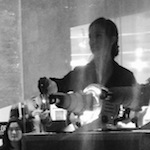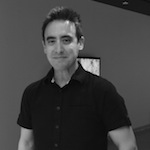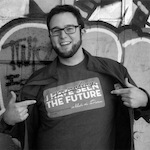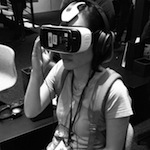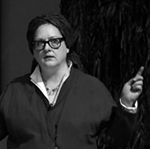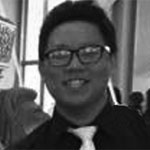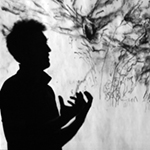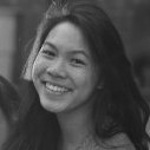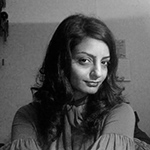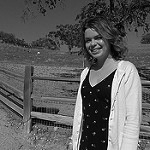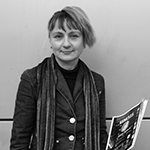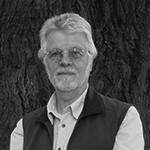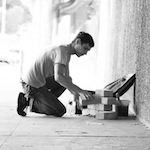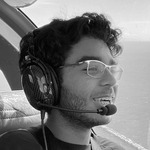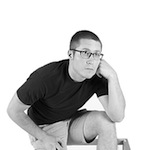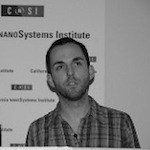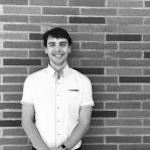Collective

Adam Stieg
nanopicolab.cnsi.ucla.edu/stieg
Adam Stieg serves as Director for the Sci|Art NanoLab Summer Institute. As a scientist and educator at the California NanoSystems Institute (CNSI), his work focuses on developing integrated approaches to study material systems at the interface of traditional boundaries. Through the implementation of original experimental techniques, this research seeks to bridge the gap between our current understanding of nanomaterials and their fundamental properties with how these systems tend toward complexity at increased scales of space and time. Dr. Stieg's research activities are augmented by active collaboration with artists and designers on various projects, installations, and public exhibitions that directly inform the scientific process and provide motivation to develop new educational content that conveys the need for creativity in innovation.
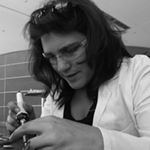
Aisen Caro Chacin
Born in Boston, MA, Aisen Caro Chacin is a regenerating composition of cells that produce a woman, an international American, and an animal whose patterns of migration are not based on seasons, but rather chance, chaos, and opportunity. Her curiosity led her to research the intersecting fields of art, science, and technology driven by conceptual forms of inquiry. Soaking with a sculpture background from the University of Houston, she also received an MFA in Design and Technology from Parsons in NYC, where she taught Physical and Creative Computing. Her radar is on Human Computer Interaction HCI- designing new perceptual interfaces; and discovering the limits of digital media. She is currently designing assistive devices as Ph.D. candidate at the Empowerment Informatics program in the University of Tsukuba, Japan. Her work has been presented and exhibited at Ars Electronica, Cite du Design, TEI, NIME, NYC Museum of Art and Design, The New York Hall of Science, Contemporary Arts Museum Houston, among others. Featured as an inventor in Future Tech by Discovery Channel, Creative Applications, FastCo, Time Techland, Engadget, and was awarded and published by PopSci, she looks forward to finding other suspended disbeliefs in her pocket.

Aki Yamada
https://www.linkedin.com/in/akiyamada/
Aki Yamada, PhD. is an assistant professor in the Tamagawa University in Tokyo, Japan. Aki’s unique research methodology is trained in ethnographic qualitative studies. She is particularly interested in STEAM education and will be giving a lecture to Sci|Art students about how transdisciplinary studies lead to enhanced learning, understanding, and revolutionary breakthroughs.

Amy Fang
Amy Fang is a graphic designer for the Art|Sci Center and a member of the Art|Sci Collective. Currently she is an undergraduate student majoring in Design | Media Arts and minoring in Cognitive Science. As a designer and media artist, she is interested in utilizing multimedia design to bridge the analog and digital. Her work spans several genres, and often create commentary on the construction of human identity through the lenses of anthropology, digital humanities, and psychology.

Andrew Ortiz
Andrew Ortiz is a third year transfer student in the Design Media Arts Department. His recent work involves building abstract refractive projection devices. These machines consist of precise arrangements of lights, mechanisms and optics, allowing for the manipulation of light and shadow in real time in such a way that is not possible with digital projection. Aside from using light as a medium, Andrew often works with ink, creating both large and small scale abstract environments. These are sometimes executed with various drawings tools, from garbage scraps to designed, 3D printed pen-like objects. His work blurs the line between realistic textures suggesting natural forms and simple lines that decay one by one, resulting in dynamic compositions often appearing three dimensional and having qualities of optical illusions, while also appearing quite unstable and like they make break apart at any moment. SciArt Counselor, Assistant Instructor, currently Instructor Event + Exhibition Coordinator
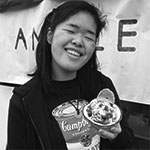
Angela Yang
Born and raised in Los Angeles, Angela Yang attended Pasadena’s Westridge School for Girls, but explored her eclectic scientific and artistic interests over the summer at UCLA’s Nanoscience Lab and Sci|Art Nanolab Summer Institute, the U.S. Naval Academy’s Summer Seminar, and Columbia University’s Materials Science and Nanotechnology Program. Additionally, she works as a research assistant for the Minnich Research Group at Caltech’s Mechanical Engineering Department. This fall, Angela will be joining University of Pennsylvania’s VIPER Class of 2021, a dual-degree program specializing in energy research. In her free time, Angela likes to explore her surroundings through food and document her adventures on Instagram.
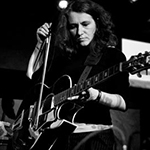
Anna Nacher
Anna Nacher, PhD, associate professor at the Jagiellonian University. Her research interests include digital culture, cultural theory, media art, sound studies and e-literature. She currently pursues a 3-year long research project on the aesthetics of post-digital imagery on a grant from Polish National Science Centre. The author of three books in Polish, the newest one published in 2016 focuses on the locative media imagery. A reworked version of one chapter has been published as "Internet of things and automation of imaging: beyond representationalism" in "communication+1", vol. 5 (2016). Other articles and chapters in edited volumes include: Techno-ecological media installations as the strategy of network, in: R. Smite, R. Smits eds. Virtualities and Realities. New Experiences, Art, and Ecologies in Immersive Environments, RIXC Center for New Media Culture, Riga 2019; In Praise of the (Post) Digital, Electronic Book Review, 5. Aug. 2018; Masaki Fujihata – On the Existence of Technical Objects, [w:] red. R. W. Kluszczyński, Augmenting the World. Masaki Fujihata and Hybrid Space-Time Art, Centrum Sztuki Współczesnej ŁAŹNIA, Gdańsk 2017; Mashup as paratextual practice: beyond digital objects (in the age of networked media), a chapter in N. Desrochers, D. Apollon (eds.), Examining Paratextual Theory and its Application in Digital Culture, Information Science Reference, IGI Global 2014. In 2018 a member of the jury for Electronic Literature Organization's N. Katherine Hayles Award for Criticism of Electronic Literature. She is also a part-time musician and sound artist focusing on field recordings.

Anne Niemetz
An Art|Sci Center alumni—will be joining us at the end of the quarter as the Bermant Foundation Resident. Anne is a media artist and designer working in the fields of wearable technology, interactive installation and audio-visual design. She is particularly fascinated by the convergence of art, science, design and technology, and she pursues collaborative and cross disciplinary projects.

Ariana Mamnoon
Ariana Mamnoon is an interdisciplinary artist, musician, and researcher living in Los Angeles. She graduated from UCLA with a B.A. in English and Geography/Environmental Systems & Society. She is a radio resident on NTS Radio as the host of "Temporal Cove" and a member of the three piece LA based project untitled (halo). Much of her work is centered on sound, environment, and finding explorative ways to portray and express art and music. Her interests lie in ecological/natural processes and human interactions, and how the two work together to produce ever changing mosaics. Some of her recent work includes curating an ambient-focused listening event during dawn on New Year's day in a tunnel, and performing at various venues and galleries with her band, such as the UCLA Broad Center for Art. Her current forms of expression are done via performing, digital collage, archival poetry, DJ mixes, and short-form videos. She loves her dog Willow and the ocean.
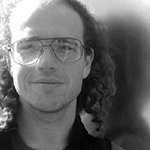
Ariel Levi Simons
Ariel Levi Simons is a PhD student at the University of Southern California in the Division of Marine and Environmental Biology and is researching ecology and aquaculture. Over the years, Simons has worked in diverse fields of education and he and his students have been involved in unique projects ranging from designing insect traps to monitor nuclear fallout from the Fukushima meltdown to building a distributed cosmic-ray detector array using cellphone cameras. He will be giving a lecture and embodied workshop on network ecologies and interspecies interactions.

Ben Ward
Ben Ward is a software engineer who develops websites for the ART|SCI Center. He is currently working remotely with Victoria Vesna to design school sites while building startups in the Silicon Valley.

Bill Fontana
I began my career as a composer. What really began to interest me was not so much the music that I could write but the states of mind I would experience when I felt musical enough to compose. In those moments, when I became musical, all the sounds around me also became musical. I have worked for the past 50 years creating installations that use sound as a sculptural medium to interact with and transform our perceptions of visual and architectural settings. These have been installed in public spaces and museums around the world including San Francisco, New York, Rome, Paris, London, Chicago, Vienna, Berlin, Venice, Sydney, Tokyo, Barcelona, Linz, Manchester, Istanbul and Abu Dhabi. My sound sculptures use the human and/or natural environment as a living source of musical information. I am assuming that at any given moment there will be something meaningful to hear and that music, in the sense of coherent sound patterns, is a process that is going on constantly. My methodology has been to create networks of simultaneous listening points that relay real time acoustic data to a common listening zone (sculpture site). Since 1976 I have called these works sound sculptures. I have produced a large number of works that explore the idea of creating live listening networks. These all use a hybrid mix of transmission technologies that connect multiple sound retrieval points to a central reception point. What is significant in this process are the conceptual links determining the relationships between the selected listening points and the site-specific qualities of the reception point (sculpture site). Some conceptual strategies have been acoustic memory, the total transformation of the visible (retinal) by the invisible (sound), hearing as far as one can see, the relationship of the speed of sound to the speed of light, and the deconstruction of our perception of time.
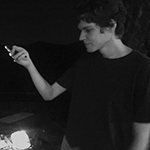
Chris Dunham
Chris Dunham is a first-year graduate student in the Gimzewski lab at UCLA. Chris received a B.S. in Chemistry at the University of Michigan - Ann Arbor. As an undergraduate, Chris spent time in biophysical and computational/theoretical research groups; following his move to UCLA, he has now made the transition to biological and materials nanoscience research in the Gimzewski lab. Because he is a first-year graduate student, Chris no longer has free time for hobbies; however, he spends what little free time he accumulates - typically in the wee hours of the night - plotting world domination. The last year has demonstrated that anything can happen.
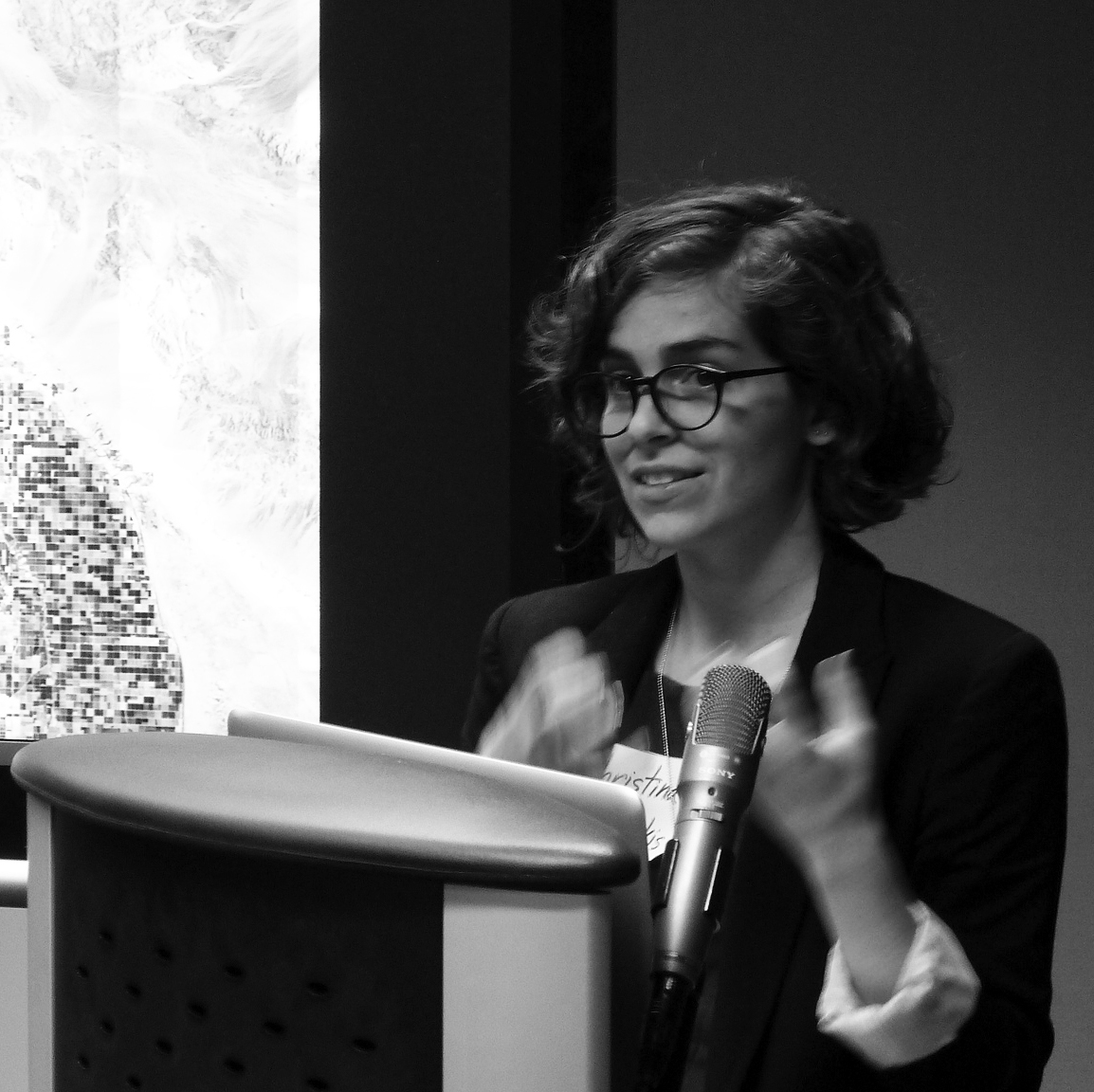
Christina Agapakis
Christina Agapakis is a synthetic biologist interested in the structure, evolution and design of the microbial communities that help us to produce and digest our food. Her research is collaborative and multidisciplinary, working with engineers, artists, and designers and ranging from the ecology of soil to skin to cheese. Her blog, Oscillator (http://blogs.scientificamerican.com/oscillator), is hosted by Scientific American.
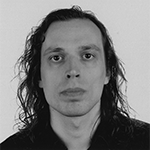
Christoph Kilian
Artist-in-Resident
Christoph Kilian is an artist and lecturer from Cologne, Germany. He studied at the Academy of Media Arts Cologne, Bauhaus-University Weimar and the ArtCenter College of Design. During his last visit to Los Angeles, he released a single snow crystal into the sky above Mount Hollywood. Currently, he is planning to silence the ocean on the nanoscale and looking for collaborators.

Clarissa Ribeiro (Brazil)
http://www.clarissaribeiro.com/
Clarissa Ribeiro, Ph.D. in Arts, M.Arch, B.Arch, former Fulbright Scholar in Arts and Science, LASER talks’ chair in Brazil. With an interest in generative strategies in nature and in the algorithmic realm of computers, Clarissa Ribeiro explores form, effectiveness and consciousness as emergent phenomena in the most diverse systems and scales in both media arts and architecture. In her artistic practice and teaching, she navigates the universes of morphogenetic design in dialogue with robotics and digital fabrication, visual/media arts in dialogue with bioart/art and science strategies, exhibiting and working in collaboration with other artists, scientists, research groups and art collectives in her home country and abroad.
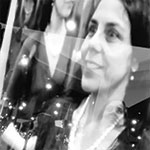
Claudia Jacques
A Brazilian-American interdisciplinary artist, designer, educator and researcher, Claudia Jacques de Moraes Cardoso holds an MFA in Computer Art (School of Visual Arts, NY) and a PhD in Integrative Art with focus on Interactive Art. Inspired by Roy Ascott and Søren Brier, she researches space-time experiences in the user-information-interface relationship through the lens of Cybersemiotics. Intersecting art, technology and science, she designs interactive hybrid art and information environments that aim to explore perceptions of space-time and the digital-physical in the pursuit of human consciousness and expansion of human knowledge. She collaborates with many artists exhibiting and presenting both nationally and internationally. She has published in Leonardo, TEKs, Art & Engine, etc., and serves as Art+Web Editor for Cybernetics and Human Knowing journal. Jacques was also a participant with three other scholars in a 2014-17 NEH Collaborative Research Project based at Roosevelt University in Chicago. She has been collaborating with UCLA’s ArtSci Center since 2011 as an Information and Instructional Design Consultant and is currently the ArtSci Lab+Studio Associate Director. Jacques teaches studio, digital and communication arts, and her studio is in Ossining, NY.
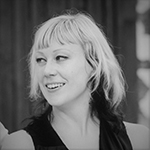
Claudia Schnugg
Claudia Schnugg is a researcher, educator, producer, and curator with an interdisciplinary background in social sciences, business administration, cultural sciences, and the arts. Currently, she is exploring the practices and social dynamics of interdisciplinary collaborative projects, involving art, science, and new technologies. Apart of her research projects she is working with institutions like Science Gallery International to support them in developing research proposals and artscience research opportunities, and consults scientific institutions in the development of artscience projects, artist in residence programs, and artscience interventions. Previously, she curated the Ars Electronica Residency Network. This included EU projects and programs in cooperation with institutions like CERN, ESO (European Southern Observatories), Queensland University of Technology, voestalpine, and Chungnam Culture Technology Industry Agency. Prior academic positions include an Assistant Professorship at the Johannes Kepler University, Linz, and a Visiting Postdoctoral Research Position at Copenhagen Business School, with special focus on organizational aesthetics and artistic interventions in business contexts.
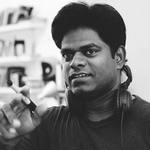
David Robert
David S. Robert is a filmmaker, writer and graphic designer. Born and brought up in Hyderabad, India, he moved to Los Angeles to make feature films for international audiences and to study film producing at UCLA. He studied Life Science in undergrad, and in grad school he double majored in Business Administration (Marketing) and Public Relations (Advertising). He has a diploma in Multimedia Arts and is well-versed in New Media. He extensively worked as an art director and creative director in film and Theatrical Poster Branding and Advertising besides writing and directing several feature shorts. He loves dogs and horses.
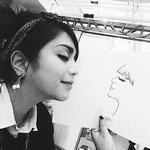
Dawn Faelnar
Dawn Faelnar is a Media Art Scientist with special interest in innovative projects that promote the beautiful collaboration between Art, Science, Design and Technology. Since graduating from the Design|Media Arts program at UCLA (minor in Neuroscience), and with nearly a decade of exposure to design development, new media and interactive technology, Dawn has been extensively involved in multimedia projects throughout the globe. Dawn spends her spare time obsessing over novelty paper, experimental music & cupcakes, and managing the continuing fundraising effort she co-founded for the victims of Typhoon Haiyan—Rebuild Cebu.

Dayan Wickramaratne
Dayan Wickramaratne is a Biomedical Engineer/Scientist, who graduated from UCLA recently. His work during ucla involved inventing a cancer diagnostic medical device for superficial cancers. He’s currently working as a curator for events at Art|Sci Center. He loves to fly drones in his free time and make aerial cinematic videos. He also plays violin and enjoy VR drawing in Google Brush. Nanolab Instructor

Edward Shanken (United States)
dward A. Shanken writes and teaches about the entwinement of art, science, and technology with a focus on interdisciplinary practices involving new media. He is Director of the Digital Arts and New Media (DANM) MFA program at UC Santa Cruz and Associate Professor in the Arts Division. Prior academic posts include Digital + Media MFA program at Rhode Island School of Design, DXARTS Ph.D. program at University of Washington, New Media International MA at University of Amsterdam. Fellowships include National Endowment for the Arts, American Council of Learned Societies, UCLA, University of Bremen, University of Memphis, and Washington University in St. Louis. Dr. Shanken earned a Ph.D. and MA in Art History at Duke University, an MBA at Yale University, and a BA at Haverford College.

Eli Joteva
Eli Joteva is a Bulgarian intermedia artist and researcher based in LA. With a practice rooted in photography and digital media, she is deeply influenced by contemporary research in the fields of quantum mechanics, neurophysics and machine vision. The core of her current research explores organic and computational memory systems in relationship to imaging processes of the past and future. Joteva’s work has been exhibited at Culture Hub LA (2020), SPRING/BREAK Art Show (2020), xCoax (2020), DA Fest (2019, 2017), Ars Electronica (2017), Sariev Contemporary (2018) Fischer Museum (2013) Queensland Center for Photography (2013) among others. She holds an MFA from UCLA Design | Media Arts, a BA in Fine Arts from USC Roski and most recently completed The New Normal post-graduate research program at Strelka. She has been a resident artist at Vermont Studio Center, ACRE, Photo+Sphere and an active member of UCLA Art Sci Center | Lab since 2016. She is currently a curator for SUPERCOLLIDER Gallery in Los Angeles, a procedural animation artist and a director of virtual galleries for multiple online exhibitions.
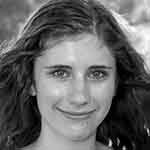
Ellen Ferranto
Ellen Ferranto is a SciArt alumna and will be sharing her fascination with scientific and technological applications of origami in a group workshop entitled “Paper Planes: Basic Folds, Structures, and Movements." Her interests include physics, history, and paper sculpture.
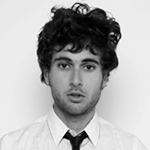
Fabricio Lamoncha
http://www.design-research-lab.org/persons/fabrizio-lamoncha/
Fabricio Lamoncha Martinez holds an MA in Interactive Media Art from the Interface Culture Lab, University of Art and Industrial Design Linz. In his work he attempts to adapt his artistic and architectural background to his growing interest in the current sociological paradigms. He currently collaborates as a student worker at the Design Research Lab in the production of various projects.

Glenn Bristol
www.flickr.com/photos/glenneroo
Glenn Bristol is a computer programmer, photographer and digital artist based in Vienna. He is one of the founding members of United Motion Labs, established in 2005. UML is an experimental lab dedicated to creating immersive audio-visual installations and Glenn is involved in every step of production — from filming, content creation, pre/post-production, VJing, DJing, creating software tools, IT administration and handling photo, video and time-lapse documentation.
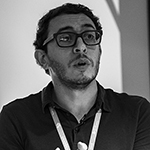
Haytham Nawar (Egypt)
http://www.aucegypt.edu/fac/haythamnawar
Nawar is an artist, designer, and researcher who currently lives and works in Cairo. He is Assistant Professor and Director of the Graphic Design program, Department of the Arts at the American University in Cairo. He is the founder and director of the Cairotronica, Cairo Electronic, and New Media Arts Festival. Nawar received his Ph.D. from the Planetary Collegium, Center for Advanced Inquiry in Integrative Arts, School of Art and Media - University of Plymouth. He holds a Masters of Advanced Studies ZFH in Spatial Design, Institute of Design & Technology, Zurich University of the Arts, Switzerland and an MFA in New Media and BFA in Printmaking from the Faculty of Fine Arts, Cairo, Egypt. He is a Fulbright alumni. Since 1999, he has participated in several international exhibitions, biennales, and triennials, the latest of which was Venice Biennial in 2015. Nawar won awards and acquisitions nationally and internationally in Algeria, Bosnia and Herzegovina, China, Cyprus, Egypt, France, Greece, Germany, Italy, Japan, Lithuania, Portugal, Kuwait, Spain, South Africa, South Korea, Switzerland, Syria, UAE and the United States.
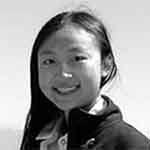
Helen [Xin] Hunag
Helen [Xin] Hunag is a junior Biology major student at UCLA, with minors in Bioinformatics, Digital Humanities, Film, and Mathematics. Energetic, positive, and enterprising, she has passion in the field of natural and historical science. She enjoys a wide range of interests including traveling, research, swimming, documentary photography, hand-crafts, and furniture design.
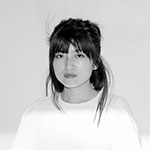
Hsinyu Lin
Hsinyu Lin is an artist / researcher / educator who studies the modes by which internet shape and gets shaped by social, cultural, economic, and political dynamics. She co-founded voidLab, an intersectional feminist collective for women, non-binary, gender nonconforming, trans and queer people to express individual identities through arts and technologies. Lin received her M.F.A. from UCLA Design | Media Arts and is currently a Visiting Professor at Loyola Marymount University. Lin’s work had been exhibited at the Hammer Museum, IndieCade Festival, Machine Project, and Gene Siskel Film Center.

Iman Person
IMAN PERSON is a first-generation Jamaican-American artist and cultural anthropologist whose research explores the intersections of Black and Indigenous technologies, and their connections to ritual, the land, language, and cosmic time. Her work goes beyond traditional Western views of technology to offer a somatic examination of cultural diasporas within the Americas and the Caribbean. In her practice, she sees the body as deeply connected to the elements, with her recent works focusing on air and ether as points of convergence for exploring collective histories, migration, and diasporic memory. Using Africana cosmologies and personal experience, Iman channels speculative visions of Black futurity through intuitive writing, video, real-time data, experimental sound, sensory ethnography, and object-making to shape unexplored ideas concerning living archives and sovereignty while navigating the delicate terrain occurring at the edges of multiple worlds. Click Here To Learn More: https://us8.admin.mailchimp.com/campaigns/wizard/neapolitan?id=2552689 An emerging area of focus for me is does sound have the capacity to embody space fully in place of the moving image. Can audiences journey and comprehend a location solely through sonic spaces and if so, where does this sound take them? Can a new destination be formed that exists outside of the present or the past by altering timescapes through sound? The core of this research engages with Kamau Bratherwaite's concept of alter/native language, which defines types of narratives that have the power to transform psychology and ways of knowing within communities of the African diaspora, which Bratherwaite believes are inherited from the teachings of colonization and the ideologies of the “mother country.” Forming alter/native languages is a discursive method that can initiate the process of re-orientation and nativizing something that has no native land to construct a more authentic voice of marginalized peoples. Brathwaite believes these languages are essential to understanding the Caribbean experience, as they reflect the region's diverse and complex cultural heritage, and provide a window into the lived experiences of its people. Not only is this creolization a melding of English or French dialects with the African or the Amerindian, but this language is also infused with the landscape itself. The weather, the quality of air, erosion, its flora, and humidity...these all alter the words created and expressed throughout the Caribbean and diasporic communities. The archives that I am currently incorporating into the work are audio are collections from prominent Caribbean linguists, narrations and reflections of the mass West Indian migration into England during 1945- 1960, lyrical prose (both self-written and found), ethnobotany and its relationship to colonial narratives in Jamaica, as well as musical excerpts of Jamaica’s sonic journey from Kuminia to present day. This project delves into sound at the juncture of Blackness and technology through codified languages that have emerged through Jamaican Patois, West Indian Creole, and other tribal communities.
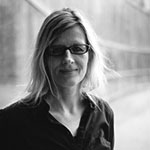
Ina Conradi
Ina Conradi, Associate Professor at the Nanyang Technological University Singapore, School of Art, Design and Media, is an award-winning digital new media artist living and working in Singapore. Her works innovatively span several disciplines: digital painting, experimental stereoscopic animation, installation, architecture and new media. Ina’s research interests are in new media art investigations through art form that redefines the wide spectrum of what painting can be. Her explorations define the new pictorial experiences that translate traditional physical act of painting into variable media spaces, innovatively employing digital animation, VFX, and since 2010 stereography.

Ivana Dama
Assistant director of the UCLA ArtSci Center
Ivana is a sound artist and researcher currently working and living in Los Angeles. She graduated from UCLA's School of Arts and Architecture in the Design Media Arts and Digital Humanities department. Her art practice includes audio-video installations, robotics, web projects, as well as music performances. Her work explores the themes of sound and space ranging from microscopic, architectural, and satellite scale. Ivana participated in more than 30 group shows and two solo exhibitions in Portland and Los Angeles.

Ivy Lovett
Ivy Lovett is an artist and graphic designer based in Southern California, and a graduate from UCLA's Design | Media Arts program. Doodling since the womb, she has always been naturally drawn to the arts, and throughout her educational career, explored and found passion in several artistic mediums ranging from fine to interactive art. As a result, her work aims to integrate illustration into a variety of media, playfully weaving together themes of nostalgia, memory, and eclecticism as a way of exploring the relationship between the tangible and the digital.
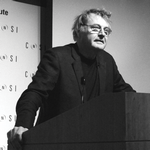
James Gimzewski
Jim Gimzewski is a Distinguished Professor of Chemistry at the University of California, Los Angeles; Director of the Nano & Pico Characterization Core Facility of the California NanoSystems Institute; Scientific Director of the Art|Sci Center and Principal Investigator and Satellites Co-Director of the WPI Center for Materials NanoArchitectonics (MANA) in Japan. Prior to joining the UCLA faculty, he was a group leader at IBM Zurich Research Laboratory, where he research in nanoscale science and technology for more than 18 years. Dr. Gimzewski pioneered research on mechanical and electrical contacts with single atoms and molecules using scanning tunneling microscopy (STM) and was one of the first persons to image molecules with STM. His accomplishments include the first STM-based fabrication of molecular suprastructures at room temperature using mechanical forces to push molecules across surfaces, the discovery of single molecule rotors and the development of new micromechanical sensors based on nanotechnology, which explore ultimate limits of sensitivity and measurement. This approach was recently used to convert biochemical recognition into Nanomechanics. His current interests are in the nanomechanics of cells and bacteria where he collaborates with the UCLA Medical and Dental Schools. He is involved in projects that range from the operation of X-rays, ions and nuclear fusion using pyroelectric crystals, direct deposition of carbon nanotubes and single molecule DNA profiling. Dr. Gimzewski is also involved in numerous art-science collaborative projects that have been exhibited in museums throughout the world.
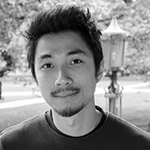
Joel Ong
https://ampd.yorku.ca/profile/joel-ong/
Joel Ong (PhD, MSc.Bioart) is a media artist whose works connect scientific and artistic approaches to the environment. His recent works explore the visibility and audibility of ambient phenomena with a particular focus on the wind and the atmospheric microbiome. His individual and collaborative works have been shown at festivals and galleries internationally such as the Currents New Media Festival, Nuit Blanche Toronto, ISEA, the Seattle Art Museum, the Gregg Museum of Art and Design, the Penny Stamps Gallery and the Ontario Science Centre. Joel is an alumni of SymbioticA, the Centre of Excellence in Biological Arts in Perth, Western Australia, and holds a PhD from DXARTS at the University of Washington. He was a recipient of the Petro-Canada Young Innovators Award in 2020 and is currently an artist with the Biofrictions Creative Europe transdisciplinary research project. He is Assistant Professor in Computational Arts and Director of Sensorium:The Centre for Digital Arts and Technology at York University.
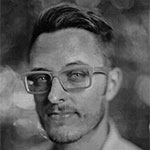
Johnatan Moore
Jonathan Fletcher Moore is a multi-dimensional (x, y, z, time) visual artist based out of Los Angeles, California. Professionally, he has spent the past seven years in the VFX / Animation industry as a lighting / compositing artist, technical director, and cg generalist. Personally, his artwork has shifted from animation and photo based works to interactive installations utilizing micro-controllers (tiny computers), the internet, and everyday objects to explore the relationship between technology, society, and the modern human condition.
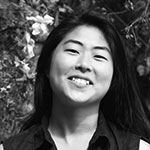
Judy Kim
Judy Kim is a second-year undergraduate at UCLA primarily studying cognitive science and film. She is a lead artist for game development and animated film teams at UCLA, often drawing from a background in 2D art but also currently learning Maya and stop motion techniques. Her interests in anthropology, psychology, philosophy, film theory, and game design revolve around understanding the mind and how both narrative and visual aspects of entertainment can positively influence our perceptions of the world. She joined the Art|Sci Center as an intern in 2015.
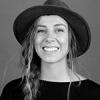
Kaitlin Bryson
Kaitlin Bryson is an ecological artist merging bioremediation – the use of biological materials to clean harmful toxins from the environment – with sculpture, performance, fiber arts and video installation. Bryson received an MFA in Art & Ecology from the University of New Mexico and has worked on environmental justice/bioremediation art projects in the Southwestern United States and in Mexico. Kaitlin has specifically studied fungi and the potential fungi hold in remediation and will be leading workshops about these potentials, as well as how we can use mushroom mycelium as a building and art material.
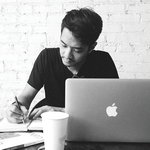
Kenneth Azurin
Kenneth Azurin is a writer with a background in art gallery exhibitions, brand growth, digital marketing and product. No stranger to UCLA's Art|Sci Center + Lab, he's contributed to recent projects such as 2013's Octopus Mandala Glow and the following year's AURORA media art science benefit show. When he's not writing for Art|Sci, Kenneth spends his time reviewing art books and novels, exploring the city, playing basketball or working on various collaborative projects as one half of th1nkblender, a creative partnership which he cofounded with Dawn Faelnar. Somewhere in between, he’s scrawling a novel.

Klaus Spiess (Austria)
Klaus Spiess is an endocrinologist, psychosomaticist and medical anthropologist who now works as an associate professor in the field of art and science at the Medical University of Vienna. His performances and installations (all together with Lucie Strecker) address biopolitical issues in medicine and have been shown at numerous performance and exhibition spaces (Budascoop Kortrijk, Tanzquartier and Belvedere/21er Haus Vienna, Haus der Kulturen der Welt, Berlin, the BEALL Center for Art + Technology, Irvine, the Onassis Cultural Center Athens, the Bemis Center of Contemporary Arts Omaha and the OK Center, Linz, where he was awarded an Honorary Mention at the Prix Ars Electronica. He has published numerous articles on his transdisciplinary work (Performance Research, Kunstforum International, Springerin, The Lancet and Leonardo, among others).
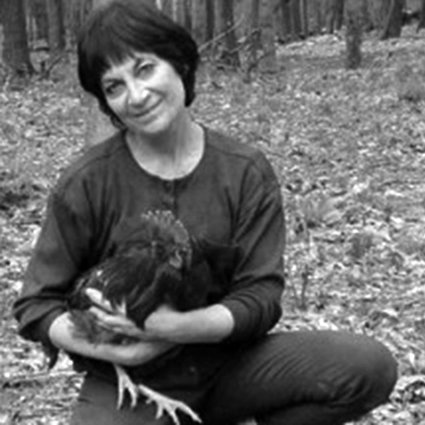
Linda Weintraub
Linda Weintraub is a curator, educator, artist, and author of several popular books about contemporary art. She has earned her reputation by making the outposts of vanguard art accessible to broad audiences. The current vanguard, she believes, is propelled by environmental consciousness that is not only the defining characteristic of contemporary manufacturing, architecture, science, ethics, politics, and philosophy, it is delineating contemporary art. “TO LIFE! Eco Art in Pursuit of a Sustainable Planet” was preceded by the series, Avant-Guardians: Textlets in Art and Ecology (2007). It includes EcoCentric Topics: Pioneering Themes for Eco-Art; Cycle-Logical Art: Recycling Matters for Eco-Art; EnvironMentalities: Twenty-two Approaches to Eco-Art. Weintraub established Artnow Publications in order to apply environmental responsibility to the books’ material production. Linda applies these environmental concerns to her personal life by managing a sustainable homestead where she practices permaculture. Weintraub is also the author of In the Making: Creative Options for Contemporary Artists and Art on the Edge and Over: Searching for Art’s Meaning in Contemporary Society. She edited ANIMAL. ANIMA. ANIMUS with Marketta Sepalla; served as the director of the Edith C. Blum Art Institute located on the Bard College campus where she originated fifty exhibitions and published over twenty catalogues; and held the position of Henry Luce Professor of Emerging Arts at Oberlin College. Dear Mother Nature at the Dorsky Museum, SUNY New Paltz is the most recent exhibition she curated. Other exhibitions include Lo and Behold: Visionary Art in the Post-Modern Era, Process and Product: The Making of Eight Contemporary Masterworks, Landmarks: New Site Proposals by Twenty Pioneers of Environmental Art, Art What Thou Eat: Images of Food in American Art, and The Maximal Implications of the Minimal Line. Weintraub received her MFA degree from Rutgers University.
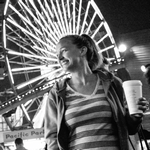
Lindy Ransom
Lindy Ransom is currently an administrative specialist working for Professor James Gimzewski at UCLA. Professor Victoria Vesna and Dr. James Gimzewski have been collaborating in various exhibits and Art|Sci Center activities for the past decade. Her background as both a coordinator and administrative assistant has both freelance feature film production experience, as well as studio executive level administration skills. Her current projects include the collaborative effort of OMG! (Victoria Vesna’s installation at Glow Festival 2013), and the parties hosted by her private event company, Events by Lindy.

Lucie Strecker (Austria)
Incoming Art|Sci artist in residence, she has been developing trans-disciplinary performances and installations that address biopolitical issues for five years. An artist and stage director, she holds a senior postdoc position at the University of Applied Arts Vienna. She has performed at Budascoop Kortrik, Tanzquartier & Belvedere/21 Haus Kortrijk, Tanzquartier and Belvedere/21er Haus, Vienna and her installations have been shown at the Haus der Kulturen der Welt in Berlin, the BEALL Center for Art + Technology in Irvine, and the OK Center in Linz, where she was awarded an Honorary Mention (2015) at the Prix Ars Electronica. She has published articles on her trans-disciplinary performances in Performance Research, Kunstforum International, Springerin, and The Lancet, among others.
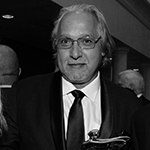
Mark Chavez
Mark Chavez is an animator, artist, educator and entrepreneur who has developed systems and techniques for animation across various media. He has worked on more than numerous award winning major feature films and innovative interactive titles to his credit at animation studios such as LaserMedia Inc. Los Angeles, Philips Interactive Media, Tokyo Broadcasting System (TBS) Japan, Acclaim Entertainment New York, Dreamworks Feature Animation Glendale and Rhythm and Hues Studios Los Angeles. Animation industry veteran and founding faculty at Nanyang Technological University’s School of Art, Design and Media’s Digital Animation area, he is currently based in Singapore and Los Angeles, founder of Giant Monster Pte Ltd. Mark holds a Master’s of Fine Art from UCLA.

Martina Fröschl (Austria)
Editor-in-chief at CGmag. After studying at the Universities of Applied Sciences in St. Pölten and Hagenberg, Martina started working for the Industrial Motion Art visual effects and digital art studio in Linz and later Vienna. Currently, she is working on her doctoral thesis at the University of Applied Arts Vienna. Under Professor Alfred Vendl she is creating marine biology animations for the new collaboration with Victoria Vesna and the ArtSci team -- the Noise Aquarium. Visiting us from Vienna, Austria, where she is a senior researcher and doctoral student at the Science Visualization Lab Angewandte at the Department of Digital Art at the University of Applied Arts Vienna. The depiction of realities and biological phenomena has continuously driven her creations. Martina will be talking with us about her collaboration/piece at SIGGRAPH, and the role that CGI and animation have played in creating very alive and immersive works about the environment.
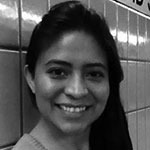
Maru Garcia
Maru García is a Mexican multidisciplinary artist whose work is inspired to capture, understand, and express the relationship and interaction between humans and Nature. Through the intersection between art, science, and technology, her work seeks to address environmental and social issues, particularly the protection of the world’s biodiversity and ecosystems.
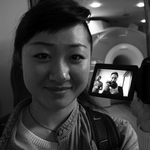
Mary Tsang
Mary Tsang is a hybrid of sorts, specialized in both Biology and Art from Carnegie Mellon University. She dabbled a lot in rainforest research and self-taught hydroponics, and has developed a passion for "do-it-yourself" biology, citizen science, and open source learning. Since graduation, she has co-initiated a documentary web-series on DIYBio and Bioart called DIYSECT, analyzing the social-political uses of biotechnology through the lens of biotinkering. She now wavers between observer and doer, using documentary video to explore the worlds she's interested in.

Maryam Razi
Maryam Razi, based in Southern California, wears multiple hats as a visual designer, eyewear artisan, freelance curator, and part-time writer. She focuses on the crossroads where art, science, technology, and culture meet. With a solid design and research foundation, Maryam is pursuing a Master of Science in User Experience, adding to her existing advanced degree.
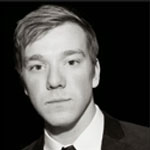
Michael Becker
Michael James Becker is an artist, designer, and researcher based in Los Angeles, California with a special interest in language, technology, and philosophy/critical theory. His practice is led by the investigation of concepts and ideas that often find their ways into environments, words and images.
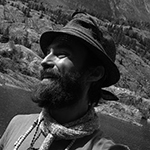
Mick Lorusso
Mick Lorusso started his art|science journey as a teenage apprentice to a Hopi Kachina sculptor and a summer intern at a biochemistry lab researching yeast for bioremediation. In his projects he interweaves musings on molecules, cells, societies, and environments. He creates images, cabinets of curiosity and interactions to address questions about energy, water, climate, and health. He has been a resident artist at interdisciplinary art programs, including PLAND / ISEA 2012: Machine Wilderness (Taos, NM, USA), the 2016 Rauschenberg Rising Waters Confab (Captiva, FL, USA), and Matza Aletsch 2017 in the Swiss Alps. At a residency in Schöppingen, Germany, Lorusso harnessed electricity-producing bacteria to illuminate a sculptural village, Microbial Schöppingen, which received a hybrid art honorary mention at Ars Electronica 2013. With early training in microbiology and education in art at Colorado College (BA) and San Francisco Art Institute (MFA), he has been a member of the UCLA Art|Sci Collective and instructor for the Sci|Art Nanolab since 2014. He is a graduate of the Waag Biohack Academy, and is a member of the Mexican interdisciplinary cooperative XOCIARTEK. He is currently a STEAM educator with Genesis in Los Angeles.

Miu-Ling Lam (Hong Kong)
Dr Miu Ling Lam is a media artist and researcher of robotics, interactive media and bioinformatics. Her most recent research focuses on 3D immaterial displays, visual-odometry-based robotic cinematography, and computational models for single molecule DNA profiling. Her work has been published in scientific journals and book chapters, such as Journal of The Royal Society Interface, Sensors and Actuators, IEEE Transactions on Robotics, and Journal of Laboratory Automation, as well as leading robotics and computer graphics conferences. Her earlier research includes multi-fingered robotic grasp, geometric algorithms for wireless sensor network deployment, and obstacle avoidance for redundant manipulators using neural network. In er postdoctoral fellowship she specialized in nanotechnology and art-science. She joined the School of Creative Media at Hong Kong CityU after her residency.

Monica C. LoCascio
Monica C. LoCascio is a multimedia artist focusing on questions of resonance, connection, and interference, particularly within and between bodies. Her work is inspired by such topics as biophotonics, particle entanglement, memory, and the thermodynamics and non-linearity of time. She is currently in the Art & Science Masters program at Die Angewandte (University of Applied Arts) in Vienna, Austria.
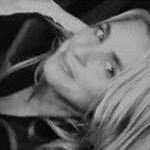
Mónica Mendes (Portugal)
is a digital media artist, designer and assistant professor coordinating the Multimedia Art degree at the University of Lisbon. She is also a researcher at M-ITI - Madeira Interactive Technologies Institute, collaborator at CIEBA – Centro de Investigação e de Estudos em Belas-Artes, and founding member of AZ Labs hackerspace altLab. Interested in designing for a more sustainable world, Mónica is exploring real-time interactive systems at the intersection of Art, Science and Technology.

Olivia Osborne
Originally from London, UK; Dr. Olivia Osborne is an interdisciplinary scientist and artist. Being a hybrid herself (English/Spanish); she has always been able to see multiple facets to her daily life and is able to integrate thoughts in an interestingly mutualistic way. Her passion lies in nature and tries to encompass that in every aspect of her life. She initiated her fervor for art at school where she took inspirational advantage of living in such a vibrant city that is London and was encouraged to exhibit and pursue her love for art. Science however, was the other main zeal in her life, which lead her to read Biological Sciences at the University of Exeter, specialising in ecotoxicology, developmental biology and environmental biology. During this time her environmental stewardship shone through as she undertook terrestrial conservation work in the jungles of Honduras and marine work in the oceans of the Bahamas. She then pursued and received her PhD in the ecotoxicology of nanomaterials from the University of Exeter, UK. Today- she swapped the quintessential picturesque Southwest England for the multifarious city of Los Angeles-where she is a postdoctoral scholar at UCLA working on the hazard assessment of nanoparticles in the environment. Her current research interests lie in environmental toxicology, nanoparticle hazard assessment and high throughput toxicity screening. Aside from being a dedicated research scientist, she keeps up her ardour for art perpetually experimenting with all forms of media, constantly exploring new ways to portray art in different forms.

Osman Trieu
Osman Trieu is a second year undergraduate NanoEngineering student studying at University of California, San Diego. He was a part of the Sci|Art program in 2014. When he is not hovering over textbooks during the school year, Osman loves to keep up to date with the latest technology news, ski, and travel around the world. He has worked with medical and innovation companies in the information technology field and research & development for the past two years, and will continue doing so with a major petroleum company this summer. He is interested in the incorporation of smart technologies into everyday lives, at both the nano and macro scale. Osman is very excited to return this year for his second time as a NanoLab counselor.

Patricia Cadavid
Patricia Cadavid is an immigrant, artist, and researcher born in Colombia. Her work looks at the relationships and effects of coloniality in new media and sound from the migratory experience and decolonial & anti-colonial thinking.Student at the Interface Culture Lab (Kunstuniversität Linz), she received her BFA from the Universidad de Castilla-La Mancha and her MA from the Universitat Politècnica de València, multimedia &Visual arts program. Her work has been exhibited in different festivals such as Ars Electronica (Austria), ADAF (Greece), or the NIME and SEAMUS conferences as well as in several spaces in Chile, Mexico, Spain, Germany, and Colombia.
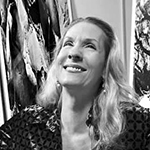
Patricia Olynyk
http://www.patriciaolynyk.com/
Her work examines the wars in which culture and institutional structures shape our knowledge and understanding of history, science, and the natural world. Appropriating medical imaging technologies and methods of collecting, documenting, and exhibiting scientific artifacts. Her work addresses how interpretation fluctuates between fact and speculation. Her installations, sculptures, photography and performances operate at the intersections between sensing and knowing, and order and affect. http://www.patriciaolynyk.com/
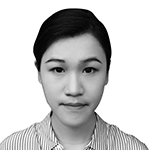
Qian Ye
Artist-in-Residence
Qian Ye (CN) holds Industrial design degree and computer science degree in Zhejiang University China. Her study filed include Tangible User Interface, Mixed Reality and Human-computer Interaction. Currently enrolled in the master program Interface Culture in University of Art and Design Linz. Her work has been exhibited in Ars Electronica 2018 & 2019 and London Design week.
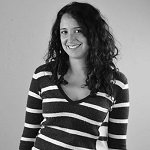
Rita Blaik
Rita Blaik is a multidisciplinary scientist and artist based in Los Angeles, California. Her life's goal is to find new and innovative ways of communicating science to people through interactive discussions, art, and other media. Since 2009 she has been an instructor for the Sci|Art Nanolab and from 2011-2012, was the Art|Sci Center Networking Outreach Coordinator. She had her first solo exhibition at the Art|Sci Center, Altered States, in Fall 2012. Rita received her B.S. in Materials Science & Engineering from the University of California at Irvine, and is currently pursuing a PhD in the same at UCLA. She is a proud fellow of the NSF IGERT Clean Energy for Green Industry fellowship and works with Professor Bruce Dunn on biological fuel cell systems and architectures.

Robertina Šebjanič
Robertina Šebjanič is an internationally awarded artist, whose work revolves around the biological, chemical, political and cultural realities of aquatic environments and explores humankind’s impact on other species and on the rights of non-human entities, while calling for strategies emphatic towards other species to be adopted. In her analysis of the theoretical framework of the Anthropocene, the artist uses the term ‘aquatocene’ and ‘aquaforming’ to refer to humans’ impact on aquatic environments. Her works received awards and nominations at Prix Ars Electronica, Starts Prize, Falling Walls.
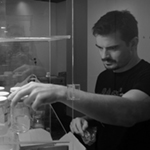
Romie Littrell
I research and create inspirational experiences from health and biotech concepts. I like to fuse digital media, tangible hardware, and storytelling into something that makes life richer as well as longer. I'm also experienced in guiding teams through user-centered design and rapid prototyping to turn things and ideas into actions.
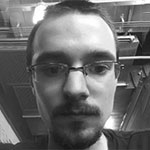
Sam Lilak
Sam Lilak received his undergraduate degree in chemistry at the University of North Dakota researching lignin, a natural biopolymer, with a focus on developing techniques to harvest its selective degradation products for the green, economical attainment of desired organic precursors and fuel products. He is currently pursuing his PhD in Chemistry at UCLA under the guidance of Dr. James Gimzewski researching the utilization of scanning probe microscopy techniques and their applications towards atomically precise manufacturing. His work in the Sci|Art program hybridizes the visual arts with techniques employed in semiconductor fabrication and manufacturing.
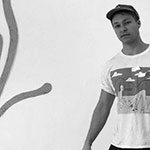
Samson Klitsner
Samson Klitsner is an LA based designer with a focus on interactive environments, motion/video and sound. As a recent graduate of the Design | Media Arts program at UCLA, his work often embraces a playful multimedia approach that combines design thinking with interactive platforms.
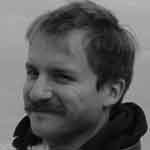
Samuel A. LoCascio
Samuel A. LoCascio obtained his PhD in Neuroscience from the Massachusetts Institute of Technology studying mechanisms of brain regeneration in flatworms. He is currently a postdoctoral fellow in the lab of Dr. S. Lawrence Zipursky at UCLA, where he studies genetic programs of neuronal wiring using the fruit fly as a model organism. Sam will talk about CRISPR Cas9 with the Sci|Art students in both research and application.
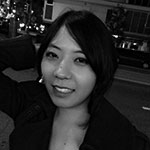
Sanglim Han
Sanglim Han is an interdisciplinary artist who focuses on the dialogue in, on, and around bodies. She explores and looks closely at our bodies through creating installations that incorporate with video, 3D animation, virtual reality, and real-time media performance. Her works have been presented internationally in various festivals and galleries including IDFX; Matadero Madrid Contemporary Art Center; Biennial Symposium for Arts and Technology. She received her BFA from the School of the Art Institute of Chicago and is currently a candidate for the MFA at UCLA DMA and a student researcher at UCLA Art Sci.

Santiago Torres
Santiago Torres is an astrophysicist working as a postdoctoral scholar in UCLA's Physics and Astronomy department. His research focuses on the dynamical interactions of different celestial bodies, from stars to planets and comets. Santiago obtained his Ph.D. in Astrophysics at Leiden Observatory in The Netherlands. Since then, he has also explored the universe through Art and traverses the intersection between Art and Science. Santiago is currently developing the project: ScienceArt:Collective {SA:C}, a space to connect and initiate collaborations between scientists and artists worldwide. Santiago has published his scientific work in several high-impact journals in astrophysics. His scientific and ArtSci works can be found here: https://santiago-torres.com

Sarah Brady
Sarah Rosalena Brady is an artist working in film, computation, sound, and installation. She challenges Western ideological systems to imply a different contextual model that is transformative and transformational: a shapeshifter. Her work has been presented at San Francisco Cinematheque, Northwest Film Forum, Gray Area Art and Technology, SOMArts Cultural Center, Fylkingen (SE), Centro Cultura Digital (MX), and the deYoung Museum.
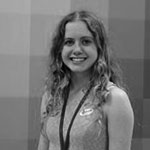
Sarah Popelka
Sarah Popelka studies cognitive science at UCLA and is interested in video games and films -- how they affect the brain, how to make them better, and how to play and watch them more.
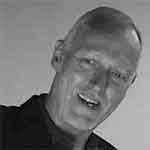
Scott Hessels
Scott Hessels is an American filmmaker, sculptor and media artist based in Hong Kong. His artworks span different media including film, video, online, music, broadcast, print, kinetic sculpture, and performance. His films have shown internationally and his new media installations have been presented in museum exhibitions focusing on technology as well as those presenting fine arts. His recognitions include patents for developed technologies, references in books and periodicals on new media art, and coverage in cultural media like Wired and Discover
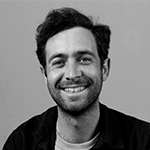
Shane Houchin
https://shanehouchin.bandcamp.com/
Shane Houchin is a California-born artist and musician, currently working towards a Geology degree in the department of Earth, Planetary, and Space Sciences at UCLA. His present focus is in geologic mapping, structural geology, igneous and metamorphic petrology, and tectonics. Bringing together his background in the arts with his geologic studies, Shane seeks to communicate science in aesthetic and engaging ways to foster an interest in the natural world and its dynamic systems. He has also recently completed an album of original music under the monicker Tujunga which will be released in late 2019.
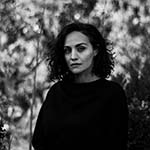
Sholeh Asgary
Sholeh Asgary is an interdisciplinary sound artist whose immersive works, performances, and audience participatory scores implicate the viewer-participant into future mythological excavations, bridging large swathes of time and history, through water, water clocks, crude oil, movement, light, imaging, voice, and sound. Asgary has exhibited and performed at such institutions as ARoS Kunstmuseum, Sotheby’s Institute of Art, Euphrat Museum, and Gray Area Foundation for the Arts. Her work has received support through numerous residencies and awards, some of which include Mass MoCA (2021), Headlands Center for the Arts (2021), California Arts Council (2020), and Kenneth Rainin Foundation NEW Commissioning grant through Dance Elixir (2019). Asgary is a Lecturer at UC Berkeley’s Department of Art Practice and serves on the curatorial council at Southern Exposure in San Francisco, CA. Born in Tehran, Iran, she holds degrees from Mills College (MFA) and San Francisco State University (BA).
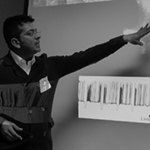
Siddharth Ramakrishnan
http://www.siddharthramakrishnan.com/
I am interested in the cusp of disciplines and the dialog that arises at that juncture. Art and Science have long been thought to be completely divergent fields, but I believe that there is a lot to be discovered by blending the two, and by allowing scientists and artists to engage with one another.

TengChao Zhou
TC Zhou is an LA-based computational media artist. He combines creative coding with gay literature written in classical Chinese. He blends programming and natural languages (in both Chinese and English) to create generative art that is interactive and animated. His work is driven by machine intelligence, producing endless variations. In addition, TC Zhou creates experimental queer games that explore queer lives. TC Zhou's games draw on his own experiences and have covered topics such as gay liberation, sex education, destigmatization, queer temporality, and the human sexuality spectrum. TC Zhou received an MFA in media arts from UCLA and a B.S. in Computer Science from NYU. He was a panelist at the UCLA Queer Graduate Research Conference (2022 & 2023). His work was shown at V2_ lab (Rotterdam), Art Machines 2 (CityU Hong Kong), SIGGRAPH DAC SPARKS, Top Art Space (Guangzhou), UCLA, and Spectra Studio (Los Angeles).
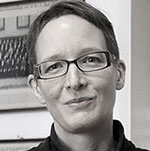
Vera Wittkowsky
Vera is a master student at the Interface Culture Lab, University of Art and Industrial Design Linz and doctoral candidate in philosophy at the University of Applied Arts Vienna. Her research interests are the artificial replica in the image of the human as well as the ethical and social implications of science and technological progress, utilizing a broad interdisciplinary approach. March and April 2019.

Victoria Vesna
Victoria Vesna, Ph.D., is a media artist and Professor at the UCLA Department of Design | Media Arts and Director of the Art|Sci center at the School of the Arts and California Nanosystems Institute (CNSI). She is currently a senior researcher at IMéRA – Institut Méditerranéen de Recherches Avancées in Marseille (2011-2013). Her work can be defined as experimental creative research that resides between disciplines and technologies. With her installations she explores how communication technologies affect collective behavior and how perceptions of identity shift in relation to scientific innovation. Victoria has exhibited her work in over twenty solo exhibitions, more than seventy group shows, has been published in excess of twenty papers and gave 100+ invited talks in the last decade. She is the North American editor of AI & Society and in 2007 published an edited volume - Database Aesthetics: Art in the age of Information Overflow, Minnesota Press and most recently an edited volume entitled Context Providers: Conditions of Meaning in Media Arts. (co-edited with Christiane Paul and Margot Lovejoy). Intellect Press, 2011.

Yolande Harris
Yolande Harris is an artist and scholar engaged with sound, its image and its role in relating humans and their technologies to the environment. Her artistic research projects consider techniques of navigation, sonification of data, sound worlds outside the human hearing range, and underwater bioacoustics. They take the form of audio-visual installations and performances, instruments, walks, performative lectures and writings. She weaves together her artwork with her theories of techno-intuition and sonic consciousness, in which expanded forms of awareness emerge through technological media and critical listening techniques. Her work is presented internationally in the context of visual art exhibitions, music venues and media art festivals and conferences.

Yonatan Rozin
Web Developer
Yonatan Rozin is a NY/NJ-based classical musician-turned-interactive technologist and web developer. A compulsive collaborator and solution-finder, Yonatan is the lead creative technologist for BodyMouth, an experimental body motion-reactive speech instrument designed by transmedia playwright Kat Mustatea which was a finalist in the 2024 Guthman Musical Instrument Competition and the Lumen Prize in the “Interactive Immersive” category. Yonatan has created several personal websites for artists and institutions, including Harvestworks Digital Media Arts Center and Atmosphere of Sound, and is passionate about offering affordable, dedicated services for creative individuals and organizations.
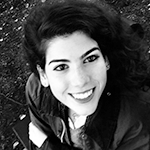
Zeynep Abes
https://vrscout.com/author/zabes/
Zeynep Abes is a new media artist who got her start at LACMA’s Art+Tech lab creating AR installations. She then worked at the 2016 Sundance Film Festival's New Frontier Exhibitions and is currently studying computer animation and game development for VR and AR.


